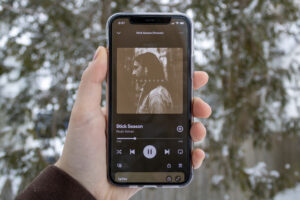Since the February 2015 release of “To Pimp a Butterfly,” Kendrick Lamar has treated fans to live versions of previously unreleased songs on late night shows and in concert. It seemed as though this is where those songs would stay: in once-off moments as opposed to a compact disc quality (CDQ) product.
But Lamar treated fans to these unused songs from “To Pimp a Butterfly,” on his album “Untitled, Unmastered.”
“Untitled, Unmastered” feels like a B-side to “TPAB,” which is not a bad thing. It builds on the jazzy, Thundercat-influenced flow of “TPAB” and includes several introspective tracks in which Lamar delves into religion and his place in the world.
The collection of work is dark and moody at times, with the songs themselves appearing to be ideas more than they are polished products. Lamar splits many of his songs into two or three parts, with sharp switches that are fun at times but sounds as if it would be better with fully-formed thoughts. The rawness is part of the charm, but can be off-putting at times.
The songs do not have names on “Untitled, Unmastered.” Instead, the eight songs are each entitled “Unmastered” 1-8, each with a different date. This can make navigating the album difficult at times, though it adds to its mysterious, unrefined nature.
Whether Lamar intended for these songs to be released or it was a response to his fans’ outcry after hearing them performed live, it’s perfect for those yearning for new Kendrick. The most gripping song and first single, nicknamed “Levitate,” is also the album’s most dynamic. Coming in at just over 8 minutes, it is divided up into three separate parts that just as easily could have been turned into two songs and an interlude. It embodies the best and worst of the album, in that the song itself is catchy and aggressive, but feels as though it was really multiple songs that were crunched together. Multiple good songs, but multiple songs nonetheless.
The album lacks the storytelling of “Good Kid, M.A.A.D. City” and the social commentary of “TPAB,” but still remains introspective and self-aware through Lamar’s journey through success. He addresses this on “Untitled 2,” which features him lamenting over his journey from Compton to the Grammys. Lamar is unsettled by the violence still happening in his hometown and flashes the brilliant honesty that makes his work special.
One of the main themes of “TPAB,” the industry “pimping” African-American artists for their own gain, is again on display early and often in “Untitled, Unmastered.” Several of the songs begin with a chorus of “Pimp, Pimp, Hooray!” This acts as a reminder of the issues still facing African-American artists and shows the responsibility that Lamar feels as a successful artist to address these issues.
“Untitled 3,” originally performed on The Colbert Report in 2014, is one of the songs that fans clamored for most after hearing it, and it does not disappoint. It takes an uncomfortably honest look at some of Lamar’s influences, ranging through different races. Lamar calls back to the idea of the industry pimping artists, rapping “That’s what the white man wanted when I rhyme, tell me he’s selling me for just $10.99.” This line embodies much of what Lamar is concerned about, and the thesis he has been rapping about for over a year.
Kendrick Lamar is an all-time rapper at the top of his game. Superstars use their platforms in different ways and, whether you agree with him or not, it’s hard not to appreciate the passion and intensity that Lamar produces music with.











